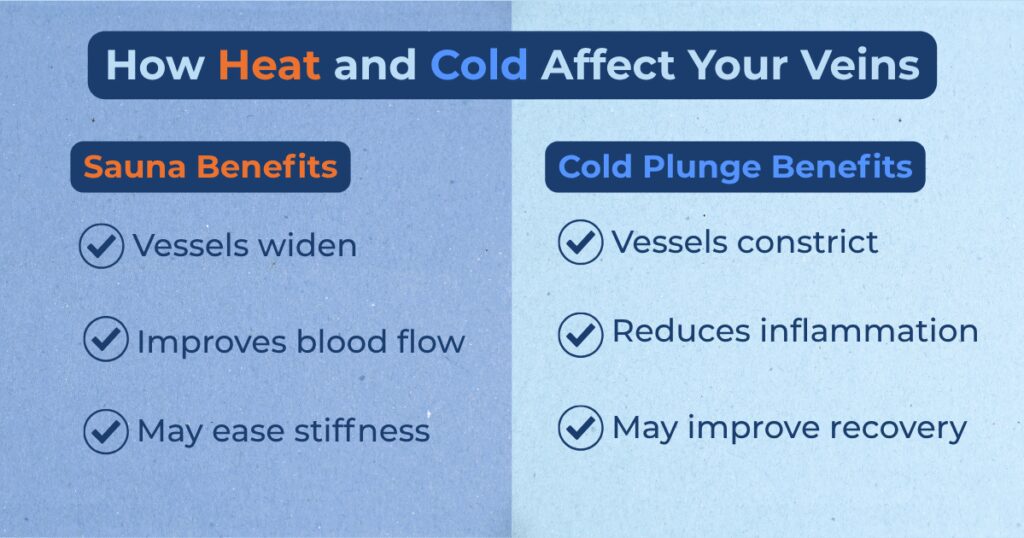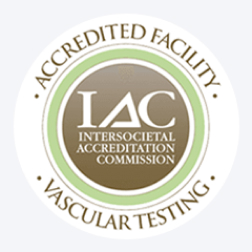Contents
- What Is Sauna Therapy? How Does It Work?
- Sauna Therapy and Vein Health: The Science Explained
- Sauna Benefits for Circulation and Vascular Health
- Potential Risks of Sauna Therapy for Vein Conditions
- What Is Cold Plunge Therapy? How Does It Work?
- Cold Plunge Therapy and Vein Health: What You Need to Know
- Combining Sauna and Cold Plunge: Contrast Therapy for Vascular Health
- Who Should Avoid Sauna or Cold Plunge Therapy?
- Safety Tips and Best Practices for Sauna and Cold Plunge Use
- When to Consult a Vein Specialist
- Making Informed Choices for Your Vein Health
- Frequently Asked Questions
Sauna and cold plunge therapy have become popular wellness trends, praised for improving circulation, recovery, and relaxation. But if you’re managing vein or vascular concerns, you might wonder: are these therapies actually good for your veins?
Sauna sessions expose the body to heat, which can temporarily widen blood vessels and boost blood flow. Cold plunges do the opposite, tightening vessels and reducing inflammation. Together, alternating between hot and cold exposure, known as contrast therapy, may help stimulate circulation and ease muscle soreness.
However, for individuals with vein conditions, these temperature changes can have mixed effects. While saunas might relieve mild swelling and stiffness, extreme heat or cold could pose risks depending on your vascular health. Before trying either therapy, it’s best to consult a vein specialist who can help you understand what’s safe for your specific needs.
What Is Sauna Therapy? How Does It Work?
Sauna therapy involves exposing your body to high temperatures in a controlled environment. This practice has been a part of many cultures for centuries. The warmth causes your body to heat up, leading to various physiological responses.
When you step into a sauna, your body’s core temperature rises. This triggers sweating, a natural way for your body to cool down. Sweating helps eliminate toxins and improves skin health.
In response to the heat, your blood vessels dilate, which enhances circulation. This expansion can increase blood flow to muscles and organs, promoting better oxygen delivery. Such improvements in circulation can be beneficial for overall vascular health.
Key benefits of sauna therapy include:
- Enhancing relaxation and reducing stress.
- Supporting detoxification through sweating.
- Potentially lowering blood pressure.
Sauna Therapy and Vein Health: The Science Explained
The science behind sauna therapy’s impact on vein health is intriguing. When exposed to heat, your blood vessels widen. This vasodilation improves blood flow, which can be vital for those with vein conditions.
Enhanced circulation may reduce the risk of blood clots. Better blood flow helps deliver nutrients and oxygen more efficiently, supporting vein function. This can be particularly beneficial for individuals with varicose veins, as it may alleviate discomfort.
However, it’s essential to consider the thermal stress involved. The heat causes your heart rate to increase, similar to moderate exercise. This boost in heart activity aids vascular function but requires caution for those with cardiovascular issues.
Sauna Benefits for Circulation and Vascular Health
Using saunas regularly can offer notable benefits for circulation. The intense heat from saunas causes blood vessels to expand. This widening improves blood flow throughout your body.
Enhanced circulation supports vein health by delivering oxygen and nutrients efficiently. This can help reduce venous pressure, providing relief from symptoms like swelling and discomfort.
Sauna sessions may also play a role in detoxification. As your body sweats, toxins are eliminated, further promoting overall vascular health. A regular sauna routine can support your body’s natural cleansing processes.
Incorporating saunas into your wellness regimen might enhance your vascular health journey.
Potential Risks of Sauna Therapy for Vein Conditions
While sauna therapy offers several benefits, it’s important to be aware of potential risks, especially for those with specific vein conditions.
Individuals with severe varicose veins or chronic venous insufficiency should exercise caution. The increased blood flow from sauna use might lead to discomfort for some.
Another consideration is for those with cardiovascular issues. The high temperature can strain the heart, posing risks for individuals with pre-existing heart conditions.
Hydration is crucial during sauna sessions. Failing to replenish fluids can lead to dehydration, which can affect blood volume and pressure.
Key risks to consider include:
- Possible discomfort for severe venous conditions.
- Increased strain for those with heart issues.
- Risk of dehydration from excessive sweating.
What Is Cold Plunge Therapy? How Does It Work?
Cold plunge therapy involves immersing the body in very cold water. This practice is used for recovery and health benefits.
The cold water causes blood vessels to constrict. This process can reduce inflammation and promote recovery.
During a cold plunge, the body’s circulation is impacted in several ways:
- Blood vessels constrict, directing blood to vital organs.
- Muscle soreness and inflammation are reduced.
- The body’s recovery process is accelerated through increased blood flow after exiting the cold.
This therapy can be invigorating but may not suit everyone. Understanding how it works can help in deciding if it’s the right fit.
Cold Plunge Therapy and Vein Health: What You Need to Know
Cold plunge therapy can have unique effects on vein health. By causing blood vessels to constrict, this therapy can temporarily reduce swelling in affected areas.
However, the impacts on individuals with vein conditions vary. For some, improved circulation upon re-warming can relieve symptoms.
In contrast, the rapid temperature change might pose challenges for others. It’s especially true for those with severe vein disorders or sensitivities.
When considering cold plunge therapy for vein health, keep these points in mind:
- Constriction of blood vessels may relieve swelling.
- Alternating temperatures can improve circulation post-therapy.
- Medical advice is essential for those with severe vein conditions.
As always, discussing with a healthcare provider ensures safety and efficacy tailored to individual needs.

Combining Sauna and Cold Plunge: Contrast Therapy for Vascular Health
Contrast therapy, involving alternating between sauna and cold plunge, can offer unique benefits for vascular health. The transition from heat to cold promotes dynamic blood vessel response. This stimulation improves circulation and supports overall vascular function.
Many people find this combination therapeutic for vein health. It may enhance flexibility in blood flow and vessel dilation, offering relief from some symptoms associated with vein conditions.
When applying contrast therapy, consider these tips for optimal benefits:
- Alternate sessions between sauna and cold plunge.
- Monitor your body’s response to temperature changes.
- Consult with a healthcare professional before starting if you have vein conditions.
Integrating these practices with professional guidance can enhance your vein health journey effectively.
Who Should Avoid Sauna or Cold Plunge Therapy?
While sauna and cold plunge therapy offer benefits, they’re not for everyone. Individuals with certain conditions should approach these therapies cautiously.
Some conditions may be contraindicated for these treatments. Notably, those with severe cardiovascular issues, including unstable heart conditions, should avoid them.
Consider avoiding these therapies if you have:
- Uncontrolled high blood pressure
- Skin infections or open wounds
- Pacemakers or other implanted medical devices
Always prioritize your health and consult with a medical professional to assess whether these therapies are safe for you.
Safety Tips and Best Practices for Sauna and Cold Plunge Use
Safety is paramount when engaging in sauna or cold plunge therapy. Understanding how to approach these treatments can enhance benefits while minimizing risks.
To practice safely, consider these tips:
- Gradually acclimate by starting with short sessions.
- Stay well-hydrated before and after.
- Avoid alcohol consumption before sessions.
- Listen to your body for signs of discomfort.
Always keep sessions within comfortable durations and avoid pushing limits. Adjust intensity according to your body’s signals to ensure a positive and rejuvenating experience. Remember, your well-being is the priority, and moderation is key in these therapies.
When to Consult a Vein Specialist
It’s crucial to recognize when professional guidance is needed. If experiencing significant discomfort, pain, or swelling, reach out to a specialist. Early intervention can prevent complications.
Consider consulting a vein specialist if you:
- Notice changes in vein appearance
- Experience persistent swelling or leg fatigue
- Have a family history of vein conditions
Timely consultations can lead to effective management and a comprehensive care plan. Addressing concerns early promotes overall vein and vascular health, ensuring peace of mind and optimal well-being.
Making Informed Choices for Your Vein Health
Sauna and cold plunge therapy can both play a role in supporting circulation and overall wellness, but understanding how they affect your veins is key to staying safe and healthy. What feels refreshing for one person may not be suitable for someone with an underlying vascular condition.
Before adding these therapies to your routine, talk with a vein specialist who can help you determine what’s best for your health goals. The experts at United Vein & Vascular Centers are here to guide you with personalized care and treatment options to keep your circulation strong and your veins healthy.
Schedule a consultation or find a clinic near you today to take the next step toward better vascular wellness.
Frequently Asked Questions
Sauna therapy may temporarily improve blood flow by widening blood vessels, which can help reduce mild swelling or stiffness. However, people with certain vein conditions should consult a specialist before using saunas regularly.
Cold plunge therapy causes blood vessels to constrict, which can reduce inflammation and improve recovery. Alternating between heat and cold, known as contrast therapy, may enhance circulation, but should be approached carefully for those with vascular issues.
Individuals with varicose veins, deep vein thrombosis, or other vascular disorders should check with a healthcare professional before trying these therapies. Sudden temperature changes can affect blood flow and may worsen some conditions.


